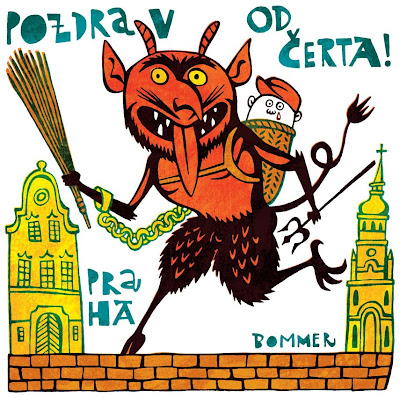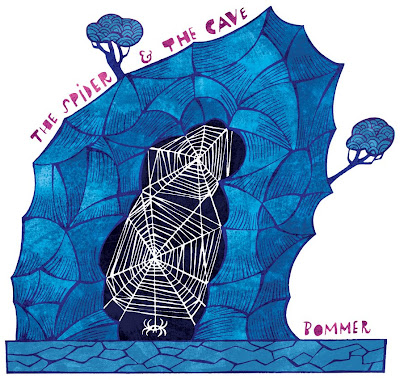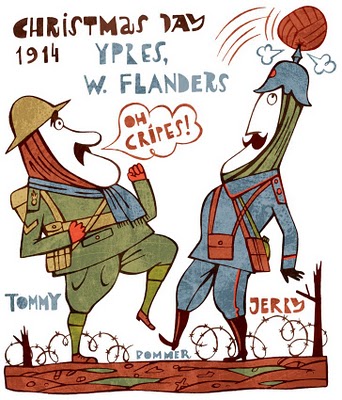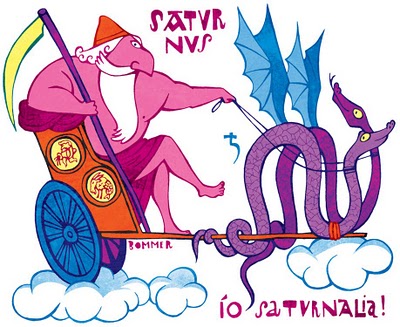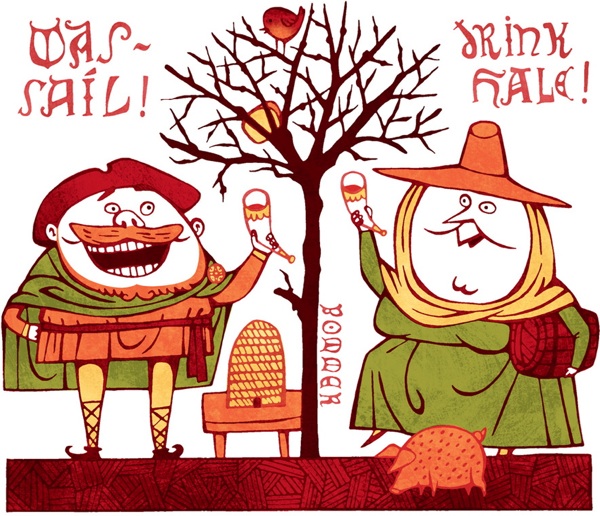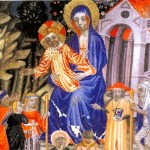a cura di Cattia Salto
Gli antichi Celti suddividevano l’anno in due parti: la metà oscura (dal 1° novembre a fine marzo) e la metà chiara (dal 1° maggio al fine ottobre).
I canti rituali dell’Inverno sono molto antichi e scandiscono il tempo stagionale di una società ancora agricola e profondamente religiosa.
Sappiamo che i Celti suddividevano la ruota dell’anno in quarti, in base alla posizione del sole.
un quarto da Natale al giorno di San Patrizio
un quarto da San Patrizio al giorno di San Giovanni
un quarto da San Giovanni al giorno di San Michele
un quarto da San Michele a Natale
e in mezzo ci sono ovviamente le quattro feste del Fuoco
Canti Rituali dell’Inverno
SOULING SONGS
Souling Plays
SAMHAIN CELTIC DANCE
SAMHAIN LEGENDS
QUESTUE NATALIZIE
CHRISTMAS IN THE ENGLISH MIDDLE AGES
CELTIC CHRISTMAS
approfondimento KILMORE CAROLS
WASSAIL & MUMMERS SONG
WREN HUNTING
I GIORNI MAGICI DELL’INVERNO
SAMAIN
San Martino
Sant’Andrea: l’inizio dell’Inverno
SAN NICOLA: IL VECCHIO BABBO NATALE
La festa di Santa Lucia
Winter solstice festival [La festa di Yule]
La festa di Santo Stefano
Sant’Antonio
Calendario dell’Avvento Il Calendario dell’Avvento di Paul Bommer in Terre Celtiche Blog per il Natale 2022
Canti di Natale
Il Natale dei Derelitti
Narrazione Biblica, Storie di Santi e Leggende di Natale
Sweet Christmas
Twelve days of Christmas
Angeli, Pastori e Magi
Canti natalizi con le piante del Natale
Canti natalizi in Bretagna
Cradle songs
Maria nei canti di natale
Canti classici e popolari sul gelo e la neve
Canti per Capodanno
GENNAIO-FEBBRAIO
La Befana
Plough Monday (il lunedì dell’aratro)
Candelora- Imbolc
Carnevale
PRIMAVERA (secondo gli antichi Celti è ancora nella metà Oscura)
La festa equinoziale di San Patrizio: il trifoglio d’Irlanda
Spring is a-coming
La danza delle Uova
La questua delle Uova
The Birds in the Spring
Canti Rituali dell’Inverno Playlist di Terre Celtiche Blog
♬La playlist di Terre Celtiche Blog per Samhain
♬La playlist di Terre Celtiche Blog per Natale
♬WASSAIL La playlist di Terre Celtiche Blog
Natività Christmas Playlist del 2022
Canti Natalizi che si ascoltano nelle chiese di Bretagna a Natale
Adeste Fideles (due versioni, una in dialetto vannetais e una in bretone),
Alleluia Iwerzhon (alleluia in irlandese),
An Noz Tenval – (Minuetto cristiano in bretone),
Anjelus Amzer Nedeleg,
Diskennit euz an neñvou,
E kreiz en noz didrouz,
En Noz Tewel – (Minuetto cristiano in bretone),
Ganet é Jézuz hor Salvér,
Ganet eo ar Mabig Jezuz,
Gloar da Zoue e barr an neñvou,
Gloria de Lourdes (in dialetto vannetais),
Gouelieù hur Salver Jezuz Krist,
Jezuz Krouedur,
Kanam Noel/Kanomp Noël/Kanamb Noel
Kanomp a vouéh ihuel/Jezuz dre garante,
Kreiz an Noz,
Martyrologe de Noël,
Meulit oll an Aotrou Doue (alleluia irlandese),
Misterieù joéius,
Ni hoc’h ador, Mabig Jezuz,
Nouel mabig Jezuz,
O na kaeret un neuéted,
O Noz heb par,
Peh trouz war an douar,
Pe trouz zo ar an douar (in dialetto vannetais),
Petra ‘zo henoz a nevez?
Petra zo henoah a neué,
Prière de bénédiction de la crèche et des santons,
Puer natus in Bethleem (in bretone),
War ar menez ar bastored,
Eit gouél er Rouané (Epifania),
Evit Gouel ar Rouaned (Epifania).
[English translation]
Some Winter ritual chants are very old and mark the seasonal time of a still agricultural and deeply religious society. We know that the Celts divided the wheel of the year into quarters, based on the position of the sun
Ráithe ó Nollaig go Féile Phádraig
Ráithe ó Fhéile Phádraig go Féile Seáin
Ráithe ó Fhéile Seáin go Féile Mhichil
‘S Ráithe ó Féile Mhichil go Nollaig
and the four festivals of Fire in between

Canti Rituali dell’Inverno: Christmas compilationS
musica strumentale di Greg Joy & Mark Bracken
Ecco gli approfondimenti dei brani in Terre Celtiche blog: O Come Emmanuel –God rest you Merry –The First Noel –Hey ho nobody’s home –Away in a manger – I wonder as I wander – Deck the halls – We three kings of orient are – Gaudete – Entre Le Boeuf Et L’ Ane Gris
La playlist di Terre Celtiche Blog per il 2021 è tutta targata Irlanda da un genio/folletto musicale, Paddy Moloney
scheda approfondimento “The Bells Of Dublin”
Celtic Christmas Podcast by Irish & Celtic Christmas Music -Marc Gunn&Carol Baril
“Merry Christmas Jig, Masters in this Hall, All Around the Holly Tree” by Peat in the Creel from Winter [strum]
“Wexford Carol” by The Selkie Girls from Winter Lore: Songs of Celtic Christmas
“Anchor” by The Grenaways from Port Isaac Christmas Album
“The Sussex Carol” by Susan Toman from Angels on High
“God Rest ye Merry Gentlemen” by Kilted Kings from Single
“Christmas Is Coming/Red Hair Boy/King’s Reel” by Eira from Glen Tidings [strum]
“Christ Child Lullaby” by Jil Chambless, Ed Miller and Scooter Muse from Nollaig Chridheil / Songs of the Christmas Season
“Merry Munster Mashup” by Carolina Ceili from Holiday Hooley [strum]
“A Virgin Queen in Bethlehem” by Catriona O’Leary from The Wexford Carols
“See Amid the Winter’s Snow” by Heather Dale from Spark
“Blessed Be That Maid Mairie” by Spencer & Beane from On Christmas Day in the Morning
“I Saw Three Ships” by A Shamrock in Kudzu from Kudzu for Christmas
“Gower Wassail” by David Pedrick from Wintertide EP
“Day Dawn” by Matt & Shannon Heaton from Fine Winter’s Night
“Good King Wenceslas” by Sarah Marie Mullen from In the Moon of Wintertime
Canti rituali dell’Inverno: Souling Songs
I primi canti rituali dell’inverno sono i Canti delle Anime, canzoni di questua che i poveri (per lo più bambini) cantavano andando di casa in casa a durante le sere tra la fine di ottobre e i primi di novembre, in occorrenza della celebrazione di Tutti i Santi (All Hallows Day = All-Souls’ eve) e della Festa dei Morti.
[English translation]
Winter Ritual Chants: Souling Songs
The First Winter Ritual Chants are the Songs of Soul, begging songs that the poor (mostly children) sang going from house to house during the evenings between the end of October and early November, with the celebration of All Saints t(All Hallows Day = All-Souls’) and of the Feast of the Deads.

La tradizione del “a-souling” oppure “a-soalin” è identica al wassailing e al caroling natalizio, però in cambio delle torte, spesso chiamate anime (in inglese soul), i questuanti promettevano di recitare delle preghiere per i defunti.
Ogni torta mangiata rappresentava un’anima che si liberava dal Purgatorio.
L’usanza è spesso vista come l’origine della moderna “Trick or Treating” (in italiano “dolcetto o scherzetto”) dei bambini mascherati da fantasmi o mostri che suonano alle porte delle case chiedendo dei “dolcetti buoni da mangiare“. Già alla fine del 1800 la tradizione di preparare il dolce si era affievolita, e dove ancora sopravviveva l’usanza della questua, si davano ai bambini delle mele o delle monetine.
Il Banchetto dei Morti
O, LAKAIT HO TROADIG (trad. bretone)
HOP TU NAA (trad. isola di Man)
Souling: la questua dei Morti
Soul Cake (Hey ho nobody home)
Soul Cake Song (We are One, Two, Three, Good Hearty Lads)
Souling song + Samhain (Kristen Lawrence)
Green grow the rushes + Soul cake (Sam Lee)
Soul Cake ricette
SAMHAIN CELTIC DANCE/La DANZA MACABRA
La danza macabra nel Medioevo
La Danza dei Morti per Samhain (danze e melodie)
La Ronda dei Morti (danza medievale)
Su ballo tondo (trad. sarda)
The Dark Morris Song (Steeleye Span- trad. fantasy)
Ad Mortem Festinamus (Llibre Vermell)
All Soul Night (Loreena McKennitt)
Ballo in Fa diesis minore (Angelo Branduardi)
The Doleful Dance Of Death (Tim Healy)
Dance of the Druid (Bear McCreary )
Passacaglia della Vita (anon. XVII sec)
The Shaking of the sheets (Steeleye Span)
“A-souling” or “a-soalin” is a tradition like wassailing and Christmas caroling, but in exchange for cakes, often called souls, the beggars promised to recite prayers for the deads.
Every cake eaten represented a soul freed from Purgatory.
The custom is often seen as the origin of the modern “Trick or Treating” of the children disguised as ghosts or monsters asking for
“some good thing to eat“.
Already at the end of the 1800s the tradition of the soul cake had faded, and where the custom of the begging still survived, children were given apples or coins.
approfondimento SAMAIN
Deireadh an Tuath (Enya)
Duan na Muthairn (antica preghiera in gaelico scozzese-Outlander TV)
Halloween (Faun)
Hallow’s eve (Lisa Theriot)
Samain (Steeleye Span)
Samhain Eve (Damh the Bard)
Samhain Night (Loreena McKennitt)
Samhain Song (Lisa Thiel)
Will O’ The Wisp (Blackmore’s Night)
SAMAIN LEGENDS
JACK O’LANTERN IN A DRESS (Devil and the Farmer’s wife)
IL MESE NERO (IN BRETAGNA)

Souling Plays
Le Souling Plays sono delle brevi scenette/pantomime dei mummers detti per l’occasione Soulers o Soul-Cakers che ancora per tutto l’Ottocento andavano di casa in casa a fine ottobre, primi di novembre a portare la buona sorte nelle case visitate.
Una tradizione ancorata nelle Isole Britanniche e successivamente nei luoghi oltreoceano di massiccia emigrazione britannica e irlandese.
Oggi in cambio della loro esibizione i Soulers chiedono birra o soldi e non più i dolcetti delle Anime.
La caratteristica principale che contraddistingue i Soulers (rispetto alle Folk Plays rituali nell’arco dell’anno) è la presenza di un “cavallo” – per lo più il teschio di un cavallo infilzato su di un manico di scopa tenuto in mano dal “Driver” il quale parla del cavallo introducendolo come “Dick”:
Entra Dick e tutti i suoi uomini,
È venuto a trovarti ancora una volta.
Una volta era vivo e ora è morto,
Non è altro che la testa di un povero vecchio cavallo!
Per il resto sono presenti gli stessi elementi delle folk plays: una lotta tra due guerrieri con la morte dello sconfitto e il suo ritorno in vita grazie all’intervento di un dottore il tutto condito da molte scherzi e buffe mosse.
Alcune famose Souling Plays sono le Guilden Sutton Play e le Rudheath (Cheshire) Souling Play, dal nome della zona in cui i primi collezionisti ottocenteschi le hanno raccolte.
The Souling Plays are short pantomimes of the mummers called Soulers or Soul-Cakers who throughout the nineteenth century still went from house to house at the end of October, beginning of November to bring good luck to the houses they visited.
A tradition anchored in the British Isles and subsequently in places overseas of massive British and Irish emigration.
Today, in exchange for their performance, Soulers ask for beer or money and no longer Souls’ sweets.
The main feature that distinguishes the Soulers (compared to the ritual Folk Plays throughout the year) is the presence of a “horse” – mostly the skull of a horse on a broomstick held in the hand of the “Driver ” who talks about the horse introducing him as “Dick”:
In comes Dick and all his men,
He’s come to see you once again.
Was once alive and now he’s dead,
And nothing but a poor old horse’s head!
We have the same elements of the folk plays: a fight between two warriors with the death of the defeated and his return to life thanks to the intervention of a doctor, all seasoned with many jokes and funny moves.
Some famous Souling Plays are the Guilden Sutton Play and the Rudheath (Cheshire) Souling Play, named after the area where the first nineteenth-century collectors collected them.
LA FESTA DI SAN MARTINO 11 novembre
LA FESTA DI SAN MARTINO: la festa di Samain (il Capodanno dei Celti) si concludeva l’11 novembre una festa pagana ancora sentita nell’Alto Medioevo, a cui la Chiesa sovrappose il culto cristiano di San Martino, era consuetudine tra i poveri e i mummers fare una questua benaugurale con l’hooden horse
St Martin’s day falls on the ‘old’ Julian calendar at “All Saints’ Day” and is therefore linked to the celebrations of the Celtish quarter-day festival (Samhain), in reverence to the souls of the dead, the poor and mummers make a begging with the hooden horse
POOR OLD HORSE (hoodening)
Festa di San Martino tra sacro e profano
Il Calendario dell’Avvento di Paul Bommer in Terre Celtiche Blog per il Natale 2022
L’artista ci ha dato l’autorizzazione a utilizzare le immagini dei suoi bellissimi disegni, così ogni giorno abbiamo aperto virtualmente una casella del Calendario per gustarci una storia, una canzone, del buon vino cotto, un dolcetto..
Paul Bommer nativo di Wembley è un disegnatore creativo, le sue serigrafie sono opere d’arte ironiche, dense di significati, di stratificazioni culturali e storiche. Un uomo dell’Est London trasferitosi nel North Norfolk, nel Regno Unito, che non smette mai di sperimentare. Ho apprezzato le sue illustrazioni di persone e cose della Vecchia Inghilterra, e anche se si occupa principalmente di serigrafie, crea opere d’arte per ogni uso, etichette di birra, piastrelle, copertine di libri, murales, insegne di botteghe e pubs, mappe concettuali.
Per conoscere meglio Paul Bommer: https://fishinkblog.com/2014/01/31/paul-bommer-cor-blimey-guvnor-a-cockney-geezer-illustrator/
http://paulbommer.blogspot.com/
http://paulbommerarchive.blogspot.com/
https://www.facebook.com/profile.php?id=100024005089669&sk=photos

Questue rituali per Natale, Capodanno e Carnevale
Le festività natalizie che si svolgono nel cuore dell’inverno sono ricche di stratificazioni di credenze e rituali, per salutare i 12 giorni del Natale (e soprattutto le notti) e per scacciare fuori il freddo inverno.
Winter Ritual Chants: Christmas, New Year and Carnival ritual chants.
However, the winter ritual songs are centered around the holiday season
The Christmas revels that take place in the middle winter are full of beliefs and rituals, to greet the 12 days of Christmas (and especially the nights) and to drive the cold winter away.
Canti Rituali dell’Inverno: CHRISTMAS OFFERING
CANTARE LE UOVA (Piemonte)
CANTO DELL’EIRESIONE (Sud Italia, Grecia)
CANTO DELLA STRINA (Sud Italia)
CANTO DELLA STREINA (Piemonte)
CANTI DELL’EGUINANE (Bretagna)
HOODENING
Levy-Dew/New Year Carol/Residue (Galles)
DA SKEKLERS (Straw men from Shethland) [uomini di paglia-Shetland]
STRAW BEAR DAY (orso di paglia, Fenland )
STRAWBOYS (uomo di paglia, Irlanda)
Il Natale dei Derelitti
The Christmas carol
CHRISTMAS IS COMIN
Fairytale of New York
The Holly and the Ivy Girl
The Rebel Jesus
I canti della Stella
Rituale natalizio diffusissimo è quello dedicato all’arrivo a Betlemme dei Re Magi, che si attua anche nella forma dell’esecuzione itinerante, spesso combinata a una questua.
Il rito della “Stella”, detto anche dei “Tre re” è un’antica tradizione delle festività natalizie -e in particolare l’Epifania- risalente al Medioevo, documentata nell’Italia del Nord, in Sardegna e in vaste aree dell’Europa centrale, germanofona, boema, ungherese e slava.
The rite of the “Star”, also known as the “Three Kings” is an ancient tradition of the Christmas holidays – and in particular the Epiphany – dating back to the Middle Ages, documented in Northern Italy, Sardinia and in large areas of Europe. Central, German-speaking, Bohemian, Hungarian and Slavic.
Il rito della Stella: I canti della “Stella” nell’arco alpino
Gesù bambin l’è nato (Piemonte)
Staffan och Herodes (tradizione svedese)
Staffan Stalledräng (tradizione svedese)
Canti Rituali dell’Inverno: WASSAIL & MUMMERS SONG
Per Natale e Capodanno nei paesi nordici è ancora viva l’usanza del Wassailing, il brindisi per festeggiare l’anno nuovo.
Ma le wassail songs sono canti di questua di natura non religiosa che risalgono sia al solstizio d’inverno che ai riti di primavera. Così il Mumping Day (oppure ‘Doleing Day’) cadeva il 21 dicembre ed era il giorno in cui i poveri andavano a chiedere l’elemosina in vista del Natale per potersi procurare tante cose buone buone (good things).
La forma più antica della celebrazione Wassail prevede la benedizione degli alberi e delle api, così importanti per l’impollinazione, al fine di garantire un raccolto sano per il prossimo anno.
In the Nordic countries the custom of Wassailing is still alive for Christmas tide and New Year, a toast to celebrate the new year.
But the wassail songs are chanting songs of a non-religious nature that date back to both the winter solstice and the spring rites. So the Mumping Day (or ‘Doleing Day’) fell on December 21st and it was the day when the poor went to beg for Christmas to be able to get so many good things.
The oldest form of the Wassail celebration provides for the blessing of trees and bees, so important for pollination, in order to ensure a healthy harvest for the next year.
APPLE TREE WASSAIL
BODMIN WASSAILING
BRING US IN A GOOD ALE
CANTO DELLA STRINA
COME LANDLORD FILL THE FLOWING BOWL
CORNISH WASSAIL
GLUOCESTERSHIRE WASSAIL
GOD BLESS THE MASTER OF THIS HOUSE
GOWER WASSAIL
GRAMPOUND WASSAIL
HEL CALENNIG
HERE WE COME A-WASSAILING
JACOBSTOW WASSAIL
JOLLY WASSAIL BOWL
MALPAS WASSAIL
MUMMER’S SONG
Omnes Gentes Plaudite
PADSTOW WASSAIL
SEASONS
SOMERSET WASSAIL
Sugar wassail/Broadwood Wassail
SUSSEX CAROL
TWELFTH DAY CAROL
WEST CORNWALL WASSAIL
L’altra usanza molto più radicata nei Canti Rituali dell’Inverno è quella del Mumming (la festa delle “mummie”, cioè le maschere) . Mummers erano uomini travestiti che indossavano maschere e andavano a visitare i loro vicini di casa in casa, cantando e ballando, un’usanza solstiziale che richiama certe tradizioni celtiche di Samain.
Il mumming implica anche una sorta di “sacra rappresentazione“, nata dalla tradizione popolare ma anche dai Mummers i mimi del villaggio che a Natale mettevano in scena una recita con personaggi stereotipati incentrata sul rito di morte-rinascita proprio di molte tradizioni solstiziali e di fine d’anno. Tra queste rappresentazioni “The Old Horse” mette in scena la morte e resurrezione del cavallo o “The Old Tup” la morte rituale di un ariete (o montone)
Si accompagnavano con i musicisti nelle notti di Natale a fare fracasso e a suonare per le strade e davanti alle case.
Queste visite notturne vennero chiamate “Wandering Waits“.
Another much more rooted winter custom is “Mumming“. Mummers were disguised men who wore masks and went to visit their neighbors at home, singing and dancing, a solstice custom that recalls Celtic Samhain.
The mumming also implies a sort of “sacred representation”, born from the popular tradition but also from the medieval mummers that staged a recital with stereotypical characters focused on the rite of death-rebirth of many solstice traditions.
Among these representations “The Old Horse” stages the death and resurrection of the horse or “The Old Tup” the ritual death of a ram.
Mummers accompanied the musicians on Christmas nights to make noise and to play on the streets and in front of the houses.
These nocturnal visits were called “Wandering Waits“.
ABBOTS BROMLEY HORNE DANCE
BOAR’S HEAD CAROL
DERBY RAM (Old Tup)
EARSDON SWORD DANCE SONG
MUMMER’S SONG
MUMMING FOR CHRISTMAS
NOVENA ZAMPOGNARI (Italy)
PAST THREE O’CLOCK (Wandering Waits)
POOR OLD HORSE
SINGING OF THE TRAVEL
TOM BAWCOCK EVE
When Good King Arthur Ruled This Land
La festa di Santo Stefano
Saint Stephen (Grateful Dead)
St Stephen’s day
Saint Stephen was a holy man
Saint Stephen was a clerk
Saint Stephen Had an Angel’s Face (Kilmore Carols)
Staffan Stalledräng
Staffan och Herodes
Canti Rituali dell’Inverno: WREN HUNTING
Sopravvissuta in Irlanda fino ai nostri giorni la caccia dello scricciolo è un rituale pan-celtico che si svolge il 26 dicembre.
Secondo la tradizione celtica lo scricciolo era il simbolo di Lugh, Figlio della Luce trionfante e il suo sacrificio, un tributo in sangue agli spiriti della Terra nel Solstizio d’Inverno, era una supplica per ottenere favori e fortuna, ma anche un sacrificio solare.
L’uccisione dello scricciolo e la distribuzione delle sue piume avrebbe portato salute e fortuna agli abitanti del villaggio.
Così il rituale pan-celtico dell’uccisione dello scricciolo e la questua benaugurale sopravvive attraverso il canto anche in Bretagna. Nel Ramo d’oro di James G. Frazer vengono descritte le usanza praticate in Francia ancora nell’Ottocento e in particolare la nomina a re di colui che riusciva a catturare per primo lo scricciolo.
Surviving in Ireland to this day the wren hunting is a pan-Celtic ritual that takes place on December 26.
According to Celtic tradition the wren was the symbol of Lugh, the triumphant Son of Light and his sacrifice, a tribute to the blood spirits of the Earth in the Winter Solstice, it was a plea to obtain favors and fortune, but also a solar sacrifice.
The killing of the wren and the distribution of its feathers would bring health and fortune to the villagers.
Thus the pan-Celtic ritual of the killing of the wren survives through song also in Brittany. James G. Frazer’s Golden Branch describes the customs practiced in France in the nineteenth century and in particular the nomination as king of the man who managed to capture the wren first.
CUTTY WREN
HELA’R DRYW
HELG YN DREAIN
HUNTING THE WREN: wren tune
PLEASE TO SEE THE KING
WREN BOYS’ SONG
WREN SONG
WREN IN THE FURZE
MARV AL LAOUENAN (breton song)
Questua del Merlo (Toscana)
CHRISTMAS IN THE ENGLISH MIDDLE AGES
Deck the hall with magical winter plants [le piante magiche dell’Inverno]
Christmas candle [candela di Natale]
Jolly Wassail Bowl [wassail e la coppa del brindisi]
Yule Log [ceppo di Natale]
Boar’s head [testa del cinghiale]
CELTIC CHRISTMAS
A Ìosa A Laogh-Dhil
Airdí Cuan
Bí a Íosa im’ Chroíse
Christmas In Carrick [An Ciarrí Carúl Nollag]
( Ireland )
Christmas in Killarney ( Ireland )
Christ’s Lullaby ( Scotland )
Don Oiche Ûd I mBeithil
Kerry Christmas Carol ( Ireland )
KILMORE CAROLS ( Ireland )
Plygain Carol ( Wales )
Manx Lullaby ( Isle of Man )
Oíche Nollag
Sussex Carol ( England )
Canti Rituali dell’Inverno: Canti di Natale
Nel medioevo la carola era una danza diffusa in tutta Europa sia in ambito popolare che aristocratico: il solista-conduttore della danza cantava le strofe e sul ritornello intonato da tutti i partecipanti e avveniva la vera e propria danza, sia in cerchio che in fila ossia a catena. La lingua utilizzata era il volgare e non aveva propriamente carattere religioso cristiano, anzi la Chiesa considerava la carola uno strumento diabolico che ancorava la gente del popolo alle antiche tradizioni e ai vecchi dei. Solo a partire dal XIV secolo venne creata la carola religiosa, perlopiù utilizzando le melodie delle carole profane con testi rielaborati o anche totalmente riscritti che conobbe una vasta diffusione nel XV secolo. In Inghilterra la carola rifiorì in epoca Vittoriana come inno religioso facendo diventare le carols sinonimo di canto natalizio. continua
Carols & Christmas chants
In the Middle Ages the carola was a dance spread throughout Europe both in the popular and aristocratic: the soloist-conductor of the dance sang the verses and the refrain matched by all the participants and took place the dance, both in a circle or in chain. The language used was the vernacular and the carola did not really have a Christian religious character, indeed the Church considered it a diabolical tool that anchored the people to ancient traditions and old gods. Only from the XIV century the religious carola was created, mostly using the melodies of the profane carols with reworked texts or even totally rewritten that knew a wide diffusion in the XV century. In England the carola flourished again in the Victorian era as a religious hymn, making carols the synonym of Christmas carol.
Narrazione Biblica, Storie di Santi e Leggende di Natale

ANIMAL CAROL
BETHEHEM DOWN
CARNAL AND THE CRANE
CANT DELS OCELLS
CAROL OF THE BIRDS
CHERRY TREE CAROL
CHRISTMAS STORKE
DOWN IN YON FOREST
GOOD KING WENCESLAS
HEROD AND THE COCK
JOY TO THE WORLD
KING PHARIM
(La) Légende de Saint Nicolas
LORD OF THE DANCE
MIRACULOUS HARVEST
NIGHT BEFORE CHRISTMAS
SAINT STEPHEN
SAINT STEPHEN WAS A CLERK
SANKTA LUCIA
STAFFAN STALLEDRÄNG
Dolce Natale
CHRISTMAS IN KILLARNEY
FIGGY PUDDING
I’ll Be Home For Christmas
In Honour Of Saint John We Thus (Mince pies)
MISS FOGARTY’S CHRISTMAS CAKE
Pugging bag
SCOTCH BUN (Scotland)
TWELFT CAKE
WHEN GOOD KING ARTHUR RULED
YULE: I dodici giorni del Natale e la Dodicesima Notte
COME AND I WILL SING YOU (Green grow the rushes/Dilly Carol/The Ten Commandments/The Twelve Apostles)
LE DANZE DELLE SPADE NELLA TRADIZIONE POPOLARE
(THE) DARKEST MIDNIGHT IN DECEMBER
DRIVE THE COLD WINTER AWAY
HEY FOR CHRISTMAS
IO SATURNALIA
SATURNALIA: IN TABERNA QUANDO SUMUS
La Lüna E ‘L Sul
TWELVE DAYS OF CHRISTMAS
WELCOME YULE
YULE: the winter solstice festival
LE FESTE DI MEZZ’INVERNO IN CORNOVAGLIA: PER GLI SPIRITI RIBELLI
ANGELI, ADORAZIONE PASTORI e MAGI
ADESTE FIDELES
ANGELS WE HAVE HEARD ON HIGH
ANGELUS AD VIRGINEM
ANGES DANS NOS CAMPAGNES
BELLS OVER BELFAST
BRADFIELD
BRING A TORCH JEANETTE ISABELLA
ḈÀ, BERGERS, ASSEMNLONS-NOUS
LA CAMBA ME FAI MAU
CAROL OF THE BELLS
DING DONG! MERRILY ON HIGH
DON OÍCHE ÚD I MBEITHIL
DO YOU HEAR WHAT I HEAR?
FIRST NOWELL
Gesù bambin l’è nato
GLORIA IN EXCELSIS DEO
GOD REST YOU MERRY GENTLEMEN
GOOD CHRISTIAN MEN, REJOICE
HARK! THE HERALD ANGELS SING
HOLY NIGHT
IL EST NÉ, LE DIVIN ENFANT
IN DULCI JUBILO
IN THE BLEAK MIDWINTER
I SAW THREE SHIP
I WONDER AS I WANDER
JESOUS AHATONHIA
JOY TO THE WORLD
Kanomp Noël
LET ALL THAT ARE TO MIRTH INCLINED
LET US THE INFANT GREET
LITTLE DRUMMER BOY
MASTERS IN THIS HALL
MINUIT, CHRÉTIENS
NOËL EST ARRIVÉ ( Malicorne )
NOËL NOUVELET
O COME ALL YE FAITHFUL
O COME EMMANUEL
ONCE IN A ROYAL DAVID’S CITY
PAST THREE O’CLOCK
PERSONENT HODIE
PÉH TROUZ ZOU AR EN DOAR
Paure Satan
RING OUT, SOLSTICE BELLS
SEE AMID THE WINTER’S SNOW
SILENT NIGHT
SIMPLE GIFT
Shepherds arise
STILLE NACHT
UN FLAMBEAU JEANNETTE ISABELLE
WELCOME YULE
WE THREE KINGS
WEXFORD CAROL
Canti natalizi con le piante del Natale
Le decorazioni natalizie, oggi fortunatamente più eco-friendly, hanno origine dall’usanza medievale di addobbare la casa con rami sempreverdi. L’usanza era però molto più antica, risalente ai riti solstiziali per sostenere il sole morente dell’Inverno. Il sempreverde era la speranza della vittoria del Sole e del rinnovarsi della vita contro le forze del male e dell’oscurità.
Chiese e case erano decorati con rami d’alloro, rosmarino, pungitopo, agrifoglio, edera e bacche. continua
Christmas carols with Christmas plants
Christmas decorations, fortunately now more eco-friendly, originate from the medieval custom of decorating the house with evergreen branches. The custom was however much older, dating back to the solstice rites to support the dying winter sun. The evergreen was the hope of the victory of the Sun and of the renewal of life against the forces of evil and darkness.
Churches and houses were decorated with laurel branches, rosemary, butcher’s broom, holly, ivy and berries.
Au gui l’an neuf
DECK THE HALLS
GET IVY AND HULL
GREEN GROWTH THE HOLLY
HOLLY AND THE IVY (The Holly bears a Berry)
HOLLY AND IVY GIRL
HOLLY KING
Ivy is Good
MISTLETOE BOUGH
MISTLETOE BOUGH (Ken Nicol)
NAY IVY NAY
SANS DAY CAROL (The Holly bears a Berry)
TANNENBAUM – CHRISTMAS TREE
Cradle songs
Tra i Christmas Carols ecco una serie di ninna-nanne dalle origini medievali ancora oggi nei repertori delle Corali e nelle compilation di musica natalizia.
Dette anche Canti della culla sono canti semplici, evocativi di un intimo momento tra Maria e Gesù. Altre ninne nanne invece sono invece più generiche, ma riferendosi alla stagione invernale sono finite nelle compilation dei canti natalizi specialmente di musica celtica
Among the Christmas Carols here is a series of lullabies from medieval origins even today in the choral repertoires and Christmas music compilations.
Also called Cradle songs are simple songs, evocative of an intimate moment between Mary and Jesus. Other generic lullabies referring to the winter season are in the compilations of Christmas songs especially of Celtic music too
ALL THROUGH THE NIGHT
AR HYD Y NOS
AS I LAY ON YULIS NIGHT
AWAY IN A MANGER
BALULALOW
BLAKE’S CRADLE SONG
CASTLE OF DROMORE
CHRIST CHILD LULLABY
CONNEMARA CRADLE SONG
COVENTRY CAROL
Entre le Boeuf et l’âne gris
LULLAY, MINE LIKING
MANX LULLABY
NENIA DI GESÙ BAMBINO
SUO GAN
TALADH CHRIOSDA
WEXFORD LULLABY
WHAT CHILD IS THIS
Maria nei canti di natale
Il culto mariano fiorì nel Medioevo attraverso i canti devozionali e di pellegrinaggio, ma il protestantesimo con la sua generalizzata disapprovazione del culto dei Santi, sminuì anche la figura di Maria, perciò nei Canti di Natale la Madonna è appena citata, tranne alcune eccezioni.
The Marian cult flourished in the Middle Ages through a lot of devotional and pilgrimage songs, but Protestantism with its generalized disapproval of the cult of the saints, also belittled the figure of Mary, so in the Christmas carols, the Mother is just mentioned, with a few exceptions.
ANGELUS AD VIRGINEM (carola 1200)
AS I LAY ON YULIS NIGHT
GABRIEL FROM HEAVEN’S KING
GABRIEL’S MESSAGE
LO, HOW A ROSE EVER BLOOMING
ROSA DAS ROSAS (cantigas 1200)
SANTA MARIA STRELA DO DIA (cantigas 1200)
SEVEN JOYS OF MARY
STELLA SPLENDENS (virelai 1300)
THERE IS NO ROSE OF SUCH VIRTUE
THIS ENDRIS NIGHT
(A) VIRGIN MOST PURE
Canti classici e popolari sul gelo e la neve
Blow, Blow to winter wind
CHESTNUTS ROASTING ON AN OPEN FIRE
CHRISTMAS AT SEA
COLD SONG
GLOOMY WINTER’S NOW AWAY
JINGLE BELLS
LET IT SNOW
LITTLE JACK FROST
SHEEP UNDER THE SNOW
SNOW
(The) snow they melt the soonest
Walking In A Winter Wonderland
Canti per Capodanno
A GUID NEW YEAR TO ANE AN’ A’
AULD LANG SYNE
CAROL OF THE BELLS
HEL CALENNIG
HOGMANAY
Levy-Dew/New Year Carol/Residue
(The) Moon Shines Bright
NOS GALAN
OLDE YEAR NOW AWAY IS FLED
ORIENTIS PARTIBUS (festa dell’Asino)
WE WISH YOU A MERRY CHRISTMAS
La Befana
LA VECCHIA STRINA
FRAU HOLLE
HEY FOR CHRISTMAS
TWELFITH NIGHT
La Candelora-IMBOLC
Il 2 Febbraio è considerato l’ultimo giorno delle celebrazioni natalizie, oggi è ancora il giorno della benedizioni delle Candele e la festa celtica di Imbolc, la festa di Fine Inverno, dedicata a rituali di purificazione dei campi e della casa. Nel Calendario di Coligny è segnata come IMBOLC – AMBIVOLCIOS celebrata dai Celti alle Calende di Febbraio
Imbolc è la festa che si trova a metà tra il Solstizio d’Inverno e l’Equinozio della Primavera ed è la prima festa della Primavera, quando spuntano i primi bucaneve e i crochi e quindi inizia a manifestarsi il rinnovamento della Natura.
E’ la festa dedicata alla dea Brigid, conosciuta in Britannia con il nome di Brigantia (in italiano Briganzia) la triplice dea del fuoco, sopravvissuta nei panni di Santa Brigida continua nella seconda parte https://terreceltiche.altervista.org/summer-ritual-chants/#1a
A Carol for Candlemas-Day: Nappy Ale both brown and stale
FÒRA L’OURS (Orso di Urbiano- Valle Susa)
Gabhaim Molta Bríde/Brigid’s Kiss
I sing of a Maiden
Maiden in the Mor Lay
Tha Bainne aig na Caoraich Uile
Carnevale
I colpi di coda dei canti rituali dell’inverno sono quelli del carnevale carnem levare, cioè nell’ipotesi accreditata dalla Chiesa di Roma nel Medioevo, “eliminare la carne”.
Il Carnevale nell’Arte Medievale
L’origine della festa però potrebbe risalire a tradizioni religiose più antiche come il “Navigium Isidis” e le Antesterie.
Iniziano le orge gastronomiche per esaurire le ultime scorte di carni prima della primavera. E insieme alla sregolatezza alimentare, la liberazione temporanea dalle regole vigenti e dai tabù. E’ per questo che il linguaggio ed i simboli del carnevale sono la parodia e i travestimenti.
Carnevale alla fine della festa, doveva essere ucciso affinché la comunità fosse liberata dal male, una morte per bruciamento, annegamento, fucilazione: un vero e proprio sacrificio! Ma prima di morire Carnevale faceva un testamento in cui denunciava i vizi e i mali dei concittadini, in tal modo purgando la collettività dei suoi peccati.
Rituali con belve o animali selvatici in genere accompagnati da un domatore sono comuni nei momenti cruciali della stagione agraria vedasi anche l’orso alpino
Carnival
The blows of the tail of the Winter Ritual Chants are those of the carnival,
that is, in the hypothesis accredited by the Church of Rome in the Middle Ages, Carnem levare “eliminate the meat”.
However, the origin of the festival could go back to more ancient religious traditions such as the “Navigium Isidis” and the Antesteria.
The gastronomic orgies start to exhaust the last stocks of meat before the spring. And along with food unruliness, temporary release from the rules in force and taboos. This is why the language and the symbols of the carnival are the parody and disguises.
Carnival at the end of the feast, had to be killed so that the community was freed from evil, a death by burning, drowning, shooting: a real sacrifice! But before he died, Carnevale made a will in which he denounced the vices and the evils of fellow citizens, thus purging the collectivity of his sins.
Rituals with beasts or wild animals usually accompanied by a tamer are common at crucial moments of the agrarian season also see the alpine bear

I Falò di Gennaio
Orientis partibus: La canzone dell’Asino (Festa dell’Asino 1 Gennaio)
Plough Monday (il lunedì dell’aratro) (tra il 7 e il 14 gennaio)
La questua di Sant’Antonio (17 gennaio inizio del Carnevale)
STRAW BEAR DAY (orso di paglia – Inghilterra)
L’UOMO DI PAGLIA: IL WEDDING STRAWBOY, LO SPOSO ANIMALE (Irlanda)
L’uomo di Paglia: dalle Isole Shetland
Up Helly Aa (Carnevale nelle isole Shetland- Scozia)
La canzone del Cappello: cantare la Martina (30 gennaio -Carnevale canavesano)
Giorni della Merla (Cremonese/Lodigiano – Lombardia)
Canti della Merla (Cremonese/Lodigiano – Lombardia)
L’ORSO E LA FOLLIA
Bal de L’Ours
L’Orso di Segale in Val Gesso (Carnevale di Valdieri)
L’asino allegro occitano: L’aze d’alegre fai testament (Provenza – Piemonte)
Saltamartin Rampino (asino) e Papà del Gnoco (Carnevale di Verona)
Le cialde di Carnevale in Piemonte: Waffles o Canestrelli?
Shroven Tuesday & Frittelle per il Carnevale Irlandese e Britannico [Pancake Day] (questua Carnevale)
Magninà la questua di Carnevale nel Basso Piemonte (questua Carnevale Langhe e Roero)
A fare confortini e berlingozzi (Carnevale della Firenze rinascimentale)
Trionfo di Bacco (Carnevale della Firenze rinascimentale)
Ballo delle fondaccine, la questua del Merlo e il Falò d’Inverno (Carnevale storico di Bibbiena)
I giorni della Mucca tigrata/The Old Cow days (calende di Aprile-Irlanda)
LINK
http://ontanomagico.altervista.org/feste-celtiche.html
http://ontanomagico.altervista.org/samain-la-festa-celtica-d-inverno.html
http://ontanomagico.altervista.org/solstizio-inverno.html
http://ontanomagico.altervista.org/imbolc-la-festa-celtica-delle-calende-di-febbraio.html
http://ontanomagico.altervista.org/san-valentino.html





